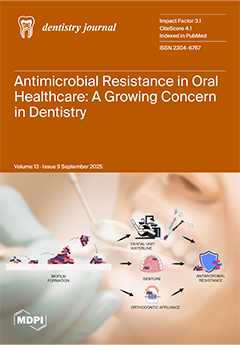Objective: This study aimed to assess the dentoskeletal and postural modifications induced by treatment with the Swallowing Occlusal Contact Intercept Appliance (SOCIA III) in patients with pseudo-Class III malocclusion. The main hypothesis was that treatment with the SOCIA appliance induces significant skeletal and dentoalveolar changes in growing patients with pseudo-Class III malocclusion.
Methods: Fifty-two pseudo-Class III malocclusion patients with a mean age of 8.5 were analyzed and compared with fifty-two untreated patients. Cephalometric evaluations were carried out at baseline (T0) and at the end of treatment. The cephalometric analysis comprised sagittal measurements (SNA, ANB, WITS, CB, ACB), dental variables (UI-PP, LI-MP, OVERJET, OVERBITE), and postural parameters (SNBa and cranio-cervical angle of the maxilla). Within-group comparisons at baseline (T0) and post-treatment (T1) were performed using the paired
t-test or the Wilcoxon signed-rank test. Inter-group comparisons were based on the differences in variables between the two time points (ΔT1–T0), using the independent samples
t-test or the Mann–Whitney U test.
Results: At the end of treatment with the SOCIA appliance, significant improvements were observed in the ANB angle (0.61° to 2.06°,
p = 0.001), SNA (81.56° to 83.26°,
p = 0.006), WITS appraisal (−0.75 mm to 1.24 mm,
p = 0.001), ACB angle (9.35 mm to 11.45 mm,
p = 0.05), CB (64.78 mm to 65.51 mm,
p = 0.03), and SNBa angle (127.57° to 129.14°,
p = 0.01), as well as in overjet (0.62 mm to 3.60 mm,
p = 0.001) and overbite (0.29 mm to 1.82 mm,
p = 0.001).
Conclusions: The SOCIA III appliance is effective in correcting pseudo-Class III malocclusion in growing patients by improving skeletal and dentoalveolar relationships.
Full article






